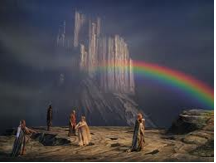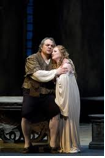Opera is such a hugely varied art form, especially now that the boundaries of the repertoire have been opened up to include works of every period, style, and nationality. But given this huge variety, where do you begin – or what direction do you take to explore further? Part of the difficulty is that there is so little preparation available: Getting into opera is almost always a hit-and-miss affair. The result is that you go to see one opera, say La Boheme or Rigoletto, and then you go to another one – Siegfried or Orfeo—and you think you’ve got something terribly wrong. Even if you have been to quite a few the same thing can happen: a composer you haven’t ventured on before – Handel or Berg – and you find yourself disappointed to find they weren’t anything remotely like what you had wanted or expected.
However, as they say, opera doesn’t have to be like that. My book, Opera, is designed to allow anyone who is serious about opera or wanting to know about opera, to know what they – as much as the composer, singers and orchestra – are meant to be doing: how to prepare so that they can play an active, intelligent and responsible part in their own experience. I would like to start by thinking about ‘absolute beginners’ and then go on to those with more experience – but who want to know more.
At the heart of this book is therefore the range of things that operas can be – and the profoundly different experiences and pleasures they can offer. But the unique combination of drama and music gives opera a number of powerful tools, one or more of which are shared by all operas: the power of melody, dramatic moments, emotional intensity, psychological exploration and theatrical complexity. Actually they can all be combined, and we can find them in any number of styles and periods – but we’ll look at different examples where each aspect shines best. (A Spotify playlist of the featured operas is also available below.)
The power of melody
For sheer melody we can turn to many composers – Puccini immediately comes to mind. But for melody that works its magic in an almost self-contained way, how about Handel’s ‘Lascia, ch’io pianga’ from Act Two of Rinaldo. Almirena has been magicked away to an enchanted palace where she is held captive by her beloved Rinaldo’s enemy (and rival) Armida. Alone, in despair at ever seeing her beloved Rinaldo again, she sings ‘Lascia ch’io pianga, / mia cruda sorte – Leave me to weep / at my cruel fate.’ Handel is a magician himself – extending just a few words to a long aria that simply breaks your heart.
Dramatic moments
 For a big dramatic moment, who better than Wagner? At the end of Das Rheingold – the first part of The Ring – the god Donner sings out ‘He da! He da! Hedo! / Zu mir, du Gedüft – Heda! Heda! Hedo / To me you mists.’ He summons thick clouds which mass together and then part as he strikes his anvil to reveal the castle Valhalla. Here Wotan plans to gather the dead heroes who will guard the gods. A rainbow shoots out to form a bridge over which the gods can enter into their new home. Huge orchestral and scenic drama, accompanied by luscious and at the same time delicate orchestral writing that bring this extraordinary and thrilling scene before our eyes.
For a big dramatic moment, who better than Wagner? At the end of Das Rheingold – the first part of The Ring – the god Donner sings out ‘He da! He da! Hedo! / Zu mir, du Gedüft – Heda! Heda! Hedo / To me you mists.’ He summons thick clouds which mass together and then part as he strikes his anvil to reveal the castle Valhalla. Here Wotan plans to gather the dead heroes who will guard the gods. A rainbow shoots out to form a bridge over which the gods can enter into their new home. Huge orchestral and scenic drama, accompanied by luscious and at the same time delicate orchestral writing that bring this extraordinary and thrilling scene before our eyes.
Emotional intensity
 Verdi is the master of emotion – but always controlled enough to remain real and not merely sentimental. In Act Two of Rigoletto, the hunchbacked court jester, finally recovers his daughter, Gilda, who has been seduced by the rapacious Duke of Mantua. Surrounded by mocking courtiers, Rigoletto summons all his powers as a father and orders them to leave. Left alone, father and daughter mourn as Gilda admits to allowing the count – albeit disguised – to seduce her. In a chain of wonderful, melodic sections, the two of them sing a long, ever-changing duet of emotional depth, sorrow and tender mutual support: ‘Parla…siam soli / Speak…we are alone.’
Verdi is the master of emotion – but always controlled enough to remain real and not merely sentimental. In Act Two of Rigoletto, the hunchbacked court jester, finally recovers his daughter, Gilda, who has been seduced by the rapacious Duke of Mantua. Surrounded by mocking courtiers, Rigoletto summons all his powers as a father and orders them to leave. Left alone, father and daughter mourn as Gilda admits to allowing the count – albeit disguised – to seduce her. In a chain of wonderful, melodic sections, the two of them sing a long, ever-changing duet of emotional depth, sorrow and tender mutual support: ‘Parla…siam soli / Speak…we are alone.’
Psychological exploration
Mozart is one of the great masters of psychology. Despite his eighteenth-century style, his music expresses all the complexity at the heart of his tormented characters. By the end of Act I of Cosí fan tutte, Fiordiligi has allowed herself to fall for another man (actually her lover’s friend in disguise – they’re both put up to the same trick to test their beloveds’ fidelity). In her aria ‘Come scoglio immoto retsta / Like a rock that remains unmoved,’ she kids herself that she can resist temptation and remain true. The music allows her a full measure of sincerity while at the same time revealing her weakness and vacillation. (If you want to see her come to a full realisation of what she has done, turn to her heartbreaking Act II ‘Per piet, ben mio, perdona – For pity, by beloved, pity me’). But here she alternates between angry resolution and new-found excitement.
Theatrical complexity
Finally, theatrical complexity. Here opera can do something unique. We have already heard the duet from Rigoletto, but in many operas there are scenes where several characters sing at the same time and the music allows us to understand what each is doing, even if the words are covered over. One of the most famous examples is the quartet in Act I of Beethoven’s Fidelio. Actually it comes as a tremendous surprise: Up to this point the opera has been something of a farce – Marcellina, the jailer Rocco’s daughter, is in love with a young man, Fidelio, who is actually the disguised wife of Floretsan, who has been condemned to death by a corrupt enemy. But Rocco’s other assistant, Jacquino, is in love with Marcellina – and is despondent at his rejection. Suddenly, starting with Marcellina’s ‘Mir ist so wunderbar – All is so wonderful to me,’ everything changes as all four soliloquys reveal what they hope or fear is to come. The music becomes solemn and formal – the quartet is actually a canon – and a new seriousness spreads over the opera as it turns from a trivial comedy about mistaken identity into a hymn to freedom and true love.
These are examples – all well-known ones – of the different kinds of thing that opera can do and experiences it can give. But this kind of immediate reaction is only a start. There is much more involved if you are to move on from here into a complete opera and then start exploring the repertoire as a whole.
To be continued in Part Two…
Editor’s Note: Download Robert Cannon’s Spotify playlist.
Latest Comments
Have your say!